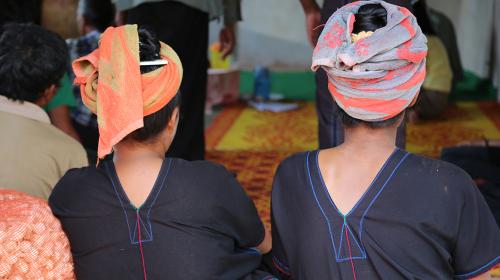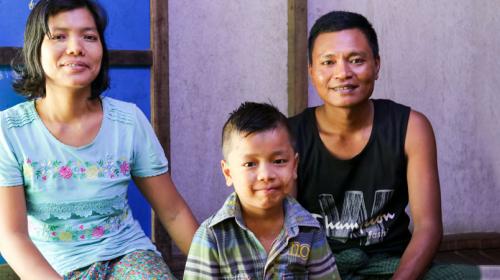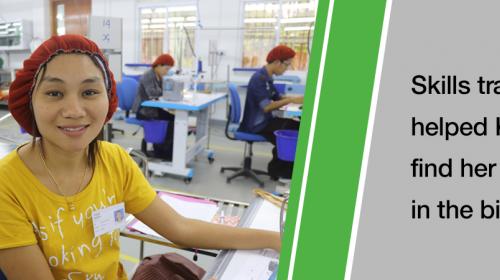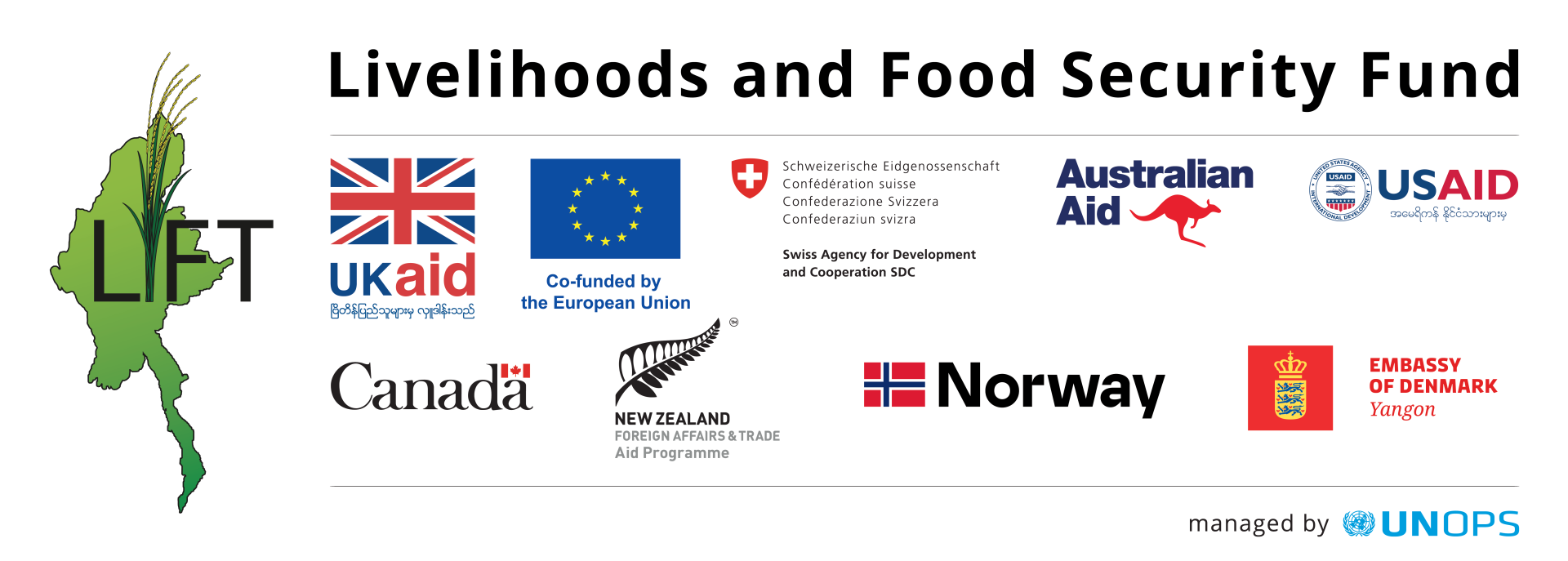
(Myanmar version below)
The LIFT-supported Agri-food Value Chain Development in Myanmar Project together with the USAID-supported Myanmar Agriculture Policy Support Activity conducted an analysis of over 2,000 households with pregnant women or young children in Yangon and the Dry Zone to provide new insight into the economic impacts of the recent political unrest and outline the efforts to protect Myanmar’s vulnerable communities from further economic shocks.
The socio-economic consequences of the unfolding political crisis have hit the most vulnerable groups in Myanmar hardest, especially migrant households with pregnant women or young children. Monthly rural-urban food security surveys were initiated in June 2020 to monitor the impacts of COVID-19 on incomes, coping strategies, food security, dietary diversity, and other nutrition-related indicators and were expanded to gauge the impacts of political instability on household welfare. Findings from these surveys show staggering employment losses, deepening poverty, and spikes in urban-to-rural migration.
Large-scale migration from Yangon, yet fewer livelihood options are available elsewhere
Economic crisis brought on by COVID-19 and accentuated by the ongoing political instability has seriously reduced incomes and impacted livelihoods for many households throughout the country, with migrant households hit hardest as many were eking out a meager income from insecure and poorly paid daily wage work. Economic hardships uprooted hundreds of thousands of people who are now on the move within the country in search for steadier livelihoods. The number of migrant households has increased, with 19 percent of surveyed Yangon households having changed residence since 2021, primarily to other states/regions, and almost half of former Yangon residents state that they have moved for over six months or permanently. About 44 percent of former Yangon residents opted to move to a rural area in a different state/region and 30 percent moved to an urban area in a different state/region, citing employment (23 percent), saving on rent/housing (35 percent), and financial support from relatives (20 percent) as the key reasons for migration.
However, migration, both to rural homelands or to new urban settlements, offered very limited employment opportunities, and with pregnant women and young children reliant on these opportunities for money, migrant families are suffering from shattering poverty.
“The share of respondents that recently lost employment was exceptionally high in May 2021. Among recent migrants, the share rose sharply from 16 to 41 percent as migrants struggled to find work in their new place of residence,” remarked a lead researcher contributing to the study.
Unemployment and raising poverty exhaust capacities of migrant families
Among the respondents, the share experiencing poverty was already very high at 55 percent since the beginning of the surveys in 2020 and largely remained at the same level for surveyed households in Yangon and the rural Dry Zone through early 2021.
“However, what is really worrying is that poverty increased by 11 percent among recent migrants from 52 percent to 63 percent. That level of poverty poses huge risks for food insecurity and malnutrition”, said a lead researcher contributing to the study.
Overall, the study reveals that Yangon’s economy – from where most of the migrants originate – has deteriorated dramatically. Another striking finding revealed that poverty rates among recent migrants in previous rounds of assessments (52 percent) were also higher than those for households who continued to stay in Yangon (46 percent), suggesting there were strong economic rationales for migration for many migrant households.
“Throughout the surveys, respondents repeatedly cited loss of employment (57 percent of surveyed Yangon households) - regular and casual labour - as a key driver of lower income and a trigger to move,” added a lead researcher.
The study revealed that the job losses rate in May 2021 (22 percent) was as high as the rate at the peak of rising COVID-19 cases in September 2020 despite preceding improvements to only 11 percent last November. Among recent migrants, however, job losses were consistently high in the second half of 2020, floating between 15 percent and 17 percent, before rising sharply to 41 percent in May 2021.
This clearly shows that migrant families have trouble finding new work in the short-term in Yangon, giving them a strong incentive to leave the city. However, those who stayed in Yangon still experienced very high rates of job losses.
Alarming changes in coping strategies signal an impending food security and nutrition crisis
Vulnerabilities, COVID-19, and political instability undermine people’s capacities to bounce back from future shocks. The most recent iteration of the survey showed that many households have already depleted their savings, other assets, and financial buffers during 2020 due to COVID-19 measures while political turmoil has added more strains on families’ overstretched ability to cope.
There have been major changes in coping strategies since late 2020. While reducing non-food consumption remained common among the surveyed households (around 40 percent to 45 percent), the share of Yangon-based households reducing food consumption rose from 6 percent to 23 percent in May 2021. This share increased from 3 percent to 15 percent among Dry Zone households and from 7 percent to 15 percent among recent migrants. Furthermore, considerably fewer surveyed households (only 11 percent in May 2021 compared to 24 percent in November 2020) were using cash savings. These results point to worrying signs that many households have exhausted their ability to use cash savings, and are now forced to cut back on food consumption and – in some cases – sell off assets. These widespread coping mechanisms may have significant long-term impacts on the nutrition situation and resilience of households.
The study further revealed that prevalence of inadequately diverse diets among mothers had risen to 21 percent despite May not being a lean season, while more families began consuming fewer types of foods. Though no significant increase in severe food insecurity experiences was documented, dietary diversity may be declining in the face of severe income shocks.
“Limited household purchasing power may force poor families to limit food purchases and reallocate food spending to less expensive and often less nutritious sources of calories, which can put pregnant women, breastfeeding mothers, and young children at a greater risk of undernutrition,” remarked a researcher.
Social safety nets have nearly collapsed
The study highlighted the collapse of national cash and food assistance schemes as a key trigger of food and nutrition insecurity. Throughout 2020, about half of respondents were receiving cash assistance from the government to cope with income loss. However, the May 2021 survey reveals that these assistance programs have all but disappeared, with just 0.9 percent of households stating that they received any assistance. With organizations experiencing multiple operational challenges in the current environment, vulnerable households in the surveyed areas appear to be receiving almost no assistance from external sources.
Continued support to migrants should include job creation strategies and augmentation of social safety nets
It is critically important for international donors and local NGOs and CSOs to find ways and means to scale up assistance to reach Myanmar’s poor, including new poor.
Amid the ongoing problems in Myanmar’s financial sectors, unconditional food assistance may be preferable. However, in the longer-term actors should consider food- or cash-for-work schemes to improve targeting and generate basic employment. Job creation should also be an essential objective in any economic recovery strategy.
As national social protection has collapsed, social safety nets urgently need to be augmented by efforts from the international community and local NGOs and CSOs, who should raise international awareness of the plight of Myanmar’s poor in the wake of such a prolonged series of economic shocks and ongoing political instability.
In view of evolving and unpredictable migration dynamics in the country, a further monitoring of vulnerable migrant groups is needed to understand their welfare dynamics and the impacts of migration on host communities, as well as further efforts to quantify the scale of migration, especially urban to rural migration.
Read the full policy note: Livelihoods, poverty, and food security in Myanmar: Household survey evidence from May 2021
.............................
အခြေပျက်ခြင်းနှင့် အလုပ်လက်မဲ့ဖြစ်ခြင်း၊ မြို့ပြမှ ကျေးလက်သို့ ရွှေ့ပြောင်းခြင်းများ အရှိန် မြင့်တက်လာ
LIFT မှ ရန်ပုံငွေပံ့ပိုးသော Agri-food Value Chain Development in Myanmar စီမံကိန်းနှင့် USAID မှ ရန်ပုံငွေပံ့ပိုးသော Myanmar Agriculture Policy Support Activity တို့ ပူးပေါင်း၍ မကြာသေး မီက ဖြစ်ပေါ်ခဲ့သော နိုင်ငံရေးမငြိမ်မသက်ဖြစ်မှု၏ စီးပွားရေးအပေါ် သက်ရောက်မှုများကို နားလည်သိရှိနိုင်စေရန်နှင့် မြန်မာနိုင်ငံရှိ ထိခိုက်လွယ်သော လူမှုအသိုင်းအဝိုင်းများအား စီးပွား ရေးဆိုင်ရာ အကျပ်အတည်းများကြောင့် ပိုမိုထိခိုက်ခြင်းမှ ကာကွယ်စောင့်ရှောက်ပေးရန်အတွက် ကြိုးပမ်းအားထုတ်မှုများကို တင်ပြနိုင်ရန် ရန်ကုန်နှင့် အပူပိုင်းဇုန်ရှိ ကိုယ်ဝန်ဆောင်အမျိုးသမီးများ သို့မဟုတ် ကလေးငယ်များ ရှိသော အိမ်ထောင်စုပေါင်း ၂,၀၀၀ ကျော်အား ဆန်းစစ်လေ့လာမှု တစ်ခု ပြုလုပ်ခဲ့ပါသည်။
ဖြစ်ပွားလျက်ရှိသည့် နိုင်ငံရေးအကျပ်အတည်း၏ လူမှုစီးပွားဆိုင်ရာ နောက်ဆက်တွဲအကျိုးဆက် များသည် မြန်မာနိုင်ငံရှိ ထိခိုက်လွယ်ဆုံးသော လူအုပ်စုများ၊ အထူးသဖြင့် ကိုယ်ဝန်ဆောင်အမျိုးသမီး သို့မဟုတ် ကလေးငယ်များ ရှိသည့် ရွှေ့ပြောင်းလုပ်သားအိမ်ထောင်စုများအပေါ် အပြင်းထန်ဆုံး ထိခိုက်စေခဲ့ပါသည်။ အကျပ်အတည်းကို ရင်ဆိုင်ကျော်လွှားသည့် နည်းလမ်းများ၊ စားနပ်ရိက္ခာဖူလုံမှုအခြေအနေ၊ ဝင်ငွေ၊ အာဟာရစုံလင်စွာ စားသုံးမှုအခြေအနေနှင့် အခြားသော အာဟာရနှင့်ဆက်နွှယ်သည့် ညွှန်ကိန်းများအပေါ် ကိုဗစ်-၁၉ ၏ သက်ရောက်မှုများကို စောင့်ကြည့်လေ့လာရန်အတွက် ၂၀၂၀ ပြည့်နှစ် ဇွန်လမှစတင်၍ ကျေးလက်-မြို့ပြ စားနပ်ရိက္ခာ ဖူလုံမှုစစ်တမ်းများကို လစဉ်ကောက်ယူခဲ့ခြင်းဖြစ်ပါသည်။ နိုင်ငံရေးမတည်ငြိမ်မှုက အိမ်ထောင်စုများ ၏ လူမှုဘဝဖူလုံမှုအပေါ် သက်ရောက်မှုများအား တိုင်းတာလေ့လာနိုင်ရန် ထိုစစ်တမ်းများကို တိုးချဲ့ဆောင်ရွက်ခဲ့ရာ အဆိုပါစစ်တမ်းများမှ တွေ့ရှိချက်များက အလုပ်အကိုင်ဆုံးရှုံးမှုများ များပြားလာခြင်း၊ ဆင်းရဲနွမ်းပါးမှုများ တိုးပွားလာခြင်းနှင့် မြို့ပြမှ ကျေးလက်သို့ ရွှေ့ပြောင်းနေ ထိုင်မှုများ မြင့်တက်လာခြင်းတို့ကို ညွှန်ပြလျက်ရှိပါသည်။
ရန်ကုန်မှ ရွှေ့ပြောင်းထွက်ခွာမှု အများအပြား ရှိနေသော်လည်း အခြားနေရာဒေသများတွင် အသက်မွေးဝမ်းကျောင်းမှု အခွင့်အလမ်းများ ရရှိနိုင်မှု ပိုမိုနည်းပါးလျက်ရှိ
ကိုဗစ်-၁၉ ကြောင့် အပြင် လက်ရှိ နိုင်ငံရေးအခြေအနေမတည်ငြိမ်မှုများကြောင့် ပိုမိုဆိုးရွား လာသည့် စီးပွားရေးအကျပ်အတည်းသည် ဝင်ငွေလျော့နည်းစေခြင်းနှင့် နိုင်ငံတစ်ဝှမ်းရှိ အိမ်ထောင်စုအများအပြား၏ သက်မွေးမှုလုပ်ငန်းများအား ထိခိုက်စေခြင်းဟူသည့် ပြင်းထန်သော ရိုက်ခတ်မှုများ ရှိနေရာ အာမခံချက်မရှိသည့် လုပ်ခလစာနည်းပါးသော နေ့စားအလုပ်များမှ မဖြစ် စလောက်ဝင်ငွေကို ခြစ်ခြုတ်သုံးစွဲနေရသော ရွှေ့ပြောင်းလုပ်သားအိမ်ထောင်စုများမှာ အထိနာဆုံး ဖြစ်ပါသည်။ သိန်းနှင့်ချီသော ပြည်သူများသည် စီးပွားရေးအကျပ်အတည်းများကြောင့် အခြေပျက်ခဲ့ရပြီး အခုအခါတွင် ပိုမိုတည်ငြိမ်ခိုင်မာသည့် အသက်မွေးဝမ်းကျောင်းမှုအလုပ်များကို ရှာဖွေရန်အတွက် နိုင်ငံအတွင်းတွင် ရွှေ့ပြောင်းနေကြရသည်။ အခြားနေရာသို့ ရွှေ့ပြောင်းနေထိုင်သော အိမ်ထောင်စုအရေအတွက်သည် မြင့်တက်လာပါသည်။ စစ်တမ်းကောက်ယူခဲ့သည့် ရန်ကုန်မှ အိမ်ထောင်စုများ၏ ၁၉ ရာခိုင်နှုန်းမှာ ၂၀၂၁ ခုနှစ်တွင် နေရာပြောင်းခဲ့ကြပြီး အဓိကအားဖြင့် အခြားပြည်နယ်/ တိုင်းဒေသကြီးများသို့ ရွှေ့ပြောင်းနေထိုင်ကြခြင်း ဖြစ်ကာ ယခင်က ရန်ကုန်တွင် နေထိုင်ခဲ့သူများ ၏ ထက်ဝက်နီးပါးက ခြောက်လကြာ သို့မဟုတ် အမြဲတမ်း နေထိုင်ရန် ပြောင်းရွှေ့ခဲ့ခြင်း ဖြစ်သည် ဟု ဖြေဆိုကြပါသည်။ ယခင်က ရန်ကုန်တွင် နေထိုင်ခဲ့ကြသူများ၏ ၄၄ ရာခိုင်နှုန်းခန့်က အခြား ပြည်နယ်/တိုင်းဒေသကြီးတစ်ခုရှိ ကျေးလက်ဒေသသို့ ပြောင်းရွှေ့ရန် ရွေးချယ်ခဲ့ကြပြီး ၃၀ ရာခိုင်နှုန်းကမူ အခြားပြည်နယ်/တိုင်းဒေသကြီးတစ်ခုရှိ မြို့ပြဒေသတစ်ခုသို့ ပြောင်းရွှေ့ခဲ့ခြင်း ဖြစ်သည်။ ပြောင်းရွှေ့ရခြင်း၏ အဓိကအကြောင်းရင်းများအဖြစ် အလုပ်အကိုင်အတွက် (၂၃ ရာခိုင်နှုန်း)၊ အိမ်ငှားခ/ အိမ်ရာနေထိုင်မှုစရိတ် သက်သာစေရန် (၃၅ ရာခိုင်နှုန်း) နှင့် ဆွေမျိုးသားချင်းများထံမှ ငွေကြေးကူညီထောက်ပံ့မှု ရရှိရန် (၂၀ ရာခိုင်နှုန်း) ဟူ၍ ဖြေဆိုကြပါသည်။
သို့သော် ကျေးလက်ဒေသရှိ ဇာတိမြေသို့ ပြန်ခြင်းဖြစ်စေ၊ အခြားမြို့ပြဒေသတစ်ခုတွင် အခြေချခြင်း ဖြစ်စေ၊ ထိုအခြေအနေနှစ်ခုစလုံးတွင် အလုပ်အကိုင် ရရှိနိုင်သည့် အခွင့်အလမ်းများ အလွန်ပင် နည်းပါးနေပြီး ကိုယ်ဝန်ဆောင်အမျိုးသမီးနှင့် ကလေးငယ်များရှိသော ရွှေ့ပြောင်းလုပ်သား မိသား စုများသည် အလုပ်အကိုင်အခွင့်အလမ်းများ ရရှိမှသာ ငွေရှာနိုင်မည်ဖြစ်သောကြောင့် ဆင်းရဲနွမ်းပါးမှု ဒဏ်ကို အလူးအလဲ ခံစားနေကြရပါသည်။
“စစ်တမ်းဖြေဆိုသူများထဲတွင် မကြာမီကမှ အလုပ်အကိုင်ဆုံးရှုံးခဲ့ရသည့်သူ အချိုးအစားသည် ၂၀၂၁ ခုနှစ် မေလတွင် သိသိသာသာ မြင့်မားနေကြောင်း၊ မကြာမီကမှ အခြားနေရာသို့ ရွှေ့ပြောင်း ကြသောသူများထဲတွင်မူ ထိုအချိုးအစားသည် ၁၆ ရာခိုင်နှုန်းမှ ၄၁ ရာခိုင်နှုန်းသို့ ထိုးတက်သွားခဲ့ ကြောင်း၊ ရွှေ့ပြောင်းလုပ်သားများသည် ၎င်းတို့ ရွှေ့ပြောင်းနေထိုင်ရာ နေရာသစ်တွင် အလုပ်အကိုင် ရှာဖွေရန် ကြိုးစားရုန်းကန်နေရသောကြောင့် ဖြစ်ကြောင်း” လေ့လာမှုတွင် ဦးဆောင်ပါဝင်ကူညီ ပေးခဲ့သည့် သုတေသနပညာရှင်တစ်ဦးက မှတ်ချက်ချခဲ့ပါသည်။
အလုပ်လက်မဲ့ဖြစ်ခြင်းနှင့် ဆင်းရဲနွမ်းပါးမှု မြင့်တက်လာခြင်းက ရွှေ့ပြောင်းလုပ်သားမိသားစုများ၏ ရင်ဆိုင်ကျော်လွှားနိုင်မှု စွမ်းရည်များကို ကုန်ခမ်းစေခဲ့
ဖြေဆိုသူများထဲတွင် ဆင်းရဲနွမ်းပါးမှုကို တွေ့ကြုံခံစားနေရသူ အချိုးအစားသည် စစ်တမ်းများ စတင်ကောက်ယူခဲ့သည့် ၂၀၂၀ ခုနှစ်ကပင် အလွန်မြင့်မားနေပြီးဖြစ်ကာ ၅၅ ရာခိုင်နှုန်း ရှိပါသည်။ ရန်ကုန်နှင့် အပူပိုင်းဇုန်ရှိ ကျေးလက်ဒေသများမှ စစ်တမ်းကောက်ယူခဲ့သည့် အိမ်ထောင်စုများ အတွက် ထိုအချိုးအစားသည် ၂၀၂၁ ခုနှစ် အစောပိုင်းကာလအထိ ယေဘုယျအားဖြင့် အပြောင်း အလဲ မရှိခဲ့ပါ။
“သို့သော် မကြာမီကမှ နေရာသစ်သို့ ရွှေ့ပြောင်းနေထိုင်သူများကြားတွင် ဆင်းရဲနွမ်းပါးမှုနှုန်းသည် ၅၂ ရာခိုင်နှုန်းမှ ၆၃ ရာခိုင်နှုန်းအထိ ၁၁ ရာခိုင်နှုန်း တိုးလာခြင်းသည် အလွန်ပင် စိုးရိမ်ပူပန်ဖွယ် ကောင်းကြောင်း၊ ဆင်းရဲနွမ်းပါးမှုနှုန်း ထိုမျှမြင့်မားလာခြင်းသည် စားနပ်ရိက္ခာမဖူလုံမှုနှင့် အာဟာ ရချို့တဲ့မှုများ ဖြစ်ပေါ်နိုင်ခြေ အလွန်ပင် မြင့်မားကြောင်း” လေ့လာမှုတွင် ဦးဆောင်ပါဝင်ကူညီ ပေးခဲ့သည့် သုတေသန ပညာရှင်တစ်ဦးက ပြောကြားခဲ့ပါသည်။
ခြုံကြည့်မည်ဆိုလျှင် ရွှေ့ပြောင်းနေထိုင်အများစု ထွက်ခွာလာခဲ့ကြသည့် ရန်ကုန်၏ စီးပွားရေး သည် များစွာ ကျဆင်းယိုယွင်းသွားခဲ့ကြောင်း လေ့လာမှုက ဖော်ပြနေပါသည်။ နောက်ထပ် ထူးခြား ထင်ရှားသည့် တွေ့ရှိချက်တစ်ခုမှာ ရှေ့ပိုင်းရှိ လေ့လာဆန်းစစ်မှုများအတွင်း မကြာမီကမှ နေရာ သစ်သို့ ရွှေ့ပြောင်းနေထိုင်သူများကြားရှိ ဆင်းရဲနွမ်းပါးမှုနှုန်း (၅၂ ရာခိုင်နှုန်း) သည် ရန်ကုန်တွင် ဆက်လက်နေထိုင်သည့် အိမ်ထောင်စုများ၏ ဆင်းရဲနွမ်းပါးမှုနှုန်း (၄၆ ရာခိုင်နှုန်း) ထက် ပိုမိုမြင့် မားနေခြင်း ဖြစ်သည်။ ဤသည်ကိုကြည့်လျှင် ရွှေ့ပြောင်းလုပ်သားအိမ်ထောင်စု အများအပြားအဖို့ ရွှေ့ပြောင်းနေထိုင်ရခြင်း၏ ခိုင်လုံသည့် အကြောင်းရင်းသည် စီးပွားရေး/အလုပ်အကိုင်အတွက် ဖြစ်ကြောင်း သိရှိနိုင်ပါသည်။
“စစ်တမ်းများအားလုံးတွင် ပုံမှန်နှင့် ကျပန်း အလုပ်အကိုင်နှစ်မျိုးစလုံး ဆုံးရှုံးရခြင်း (စစ်တမ်းကောက်ယူခဲ့သည့် ရန်ကုန်ရှိ အိမ်ထောင်စုများ၏ ၅၇ ရာခိုင်နှုန်း)မှာ ဝင်ငွေ နည်းပါးသွားစေခြင်းနှင့် ပြောင်းရွှေ့ရန် စေ့ဆော်ပေးသည့် အဓိကအချက်ဖြစ်ကြောင်း ထပ်ခါတလဲလဲ ဖြေဆိုကြသည်”ဟု ဦးဆောင်သူ သုတေသနပညာရှင်တစ်ဦးက ဖြည့်စွက် ပြောကြားပါသည်။
၂၀၂၁ ခုနှစ် မေလတွင် အလုပ်အကိုင်ဆုံးရှုံးမှုနှုန်း (၂၂ ရာခိုင်နှုန်း) သည် ကိုဗစ်-၁၉ လူနာအရေ အတွက် အမြင့်မားဆုံးဖြစ်ခဲ့သည့် ၂၀၂၀ ပြည့်နှစ် စက်တင်ဘာလက ရှိခဲ့သည့် အလုပ်အကိုင် ဆုံးရှုံးမှုနှုန်းနှင့် တန်းတူမြင့်မားနေကြောင်း လေ့လာမှုတွင် တွေ့ရှိခဲ့ပါသည်။ အမှန်စင်စစ် ယမန် နှစ် နိုဝင်ဘာလတွင် ထိုနှုန်းသည် ၁၁ ရာခိုင်နှုန်းသာ ရှိတော့သည်အထိ တိုးတက်မှုများ ပြန်လည် ရရှိခဲ့ပါသေးသည်။ သို့သော် မကြာမီက ရွှေ့ပြောင်းနေထိုင်ကြသူများကြားတွင်မူ အလုပ်အကိုင် ဆုံးရှုံးမှုများသည် ၂၀၂၀ ခုနှစ် ဒုတိယနှစ်ဝက်အတွင်း ၁၅ ရာခိုင်နှုန်းနှင့် ၁၇ ရာခိုင်နှုန်းကြား တသမတ်တည်း မြင့်မားနေခဲ့ပြီး ၂၀၂၁ ခုနှစ် မေလတွင် ၄၁ ရာခိုင်နှုန်းသို့ ထိုးတက်သွားခဲ့ခြင်း ဖြစ်ပါသည်။
ဤသည်ကိုကြည့်လျှင် ရွှေ့ပြောင်းလုပ်သားမိသားစုများသည် ရေတိုကာလအတွင်း ရန်ကုန်၌ အလုပ်သစ်ရှာဖွေရန် ခက်ခဲနိုင်ကြောင်း ထင်ရှားစွာ တွေ့ရမည်ဖြစ်ပြီး ထိုအကြောင်းကြောင့် ၎င်းတို့သည် ရန်ကုန်မြို့မှ ထွက်ခွာရန် ကြီးမားသော တွန်းအားတစ်ရပ် ဖြစ်လာခဲ့ပါသည်။ သို့သော် ရန်ကုန်တွင် ဆက်လက်နေထိုင်သူများသည်လည်း အလုပ်အကိုင်ဆုံးရှုံးမှုနှုန်းများ အလွန် မြင့်မားလျက်ရှိသည့် ပြဿနာကို ရင်ဆိုင်နေရဆဲ ဖြစ်ပါသည်။
ရင်ဆိုင်ကျော်လွှားသည့် နည်းလမ်းများသည် စိုးရိမ်ထိတ်လန့်ဖွယ် ပြောင်းလဲလာခဲ့ပြီး စားနပ် ရိက္ခာဖူလုံမှုနှင့် အာဟာရဆိုင်ရာ အကျပ်အတည်း ဆိုက်ရောက်လာတော့မည့် လက္ခဏာ တွေ့ရှိလာရ
ထိခိုက်လွယ်မှုများ၊ ကိုဗစ်-၁၉ နှင့် နိုင်ငံရေးမတည်ငြိမ်မှုတို့က ပြည်သူများ၏ အနာဂတ်တွင် ကြုံတွေ့ရ မည့် ဘေးဒုက္ခများမှ ရုန်းကန်ပြန်ထနိုင်မှုစွမ်းရည်များကို များစွာ ထိခိုက်စေပါသည်။ ယခုနောက်ဆုံး ပြင်ဆင်ကောက်ယူခဲ့သည့် စစ်တမ်းအရ အိမ်ထောင်စုအများအပြားသည် ၂၀၂၀ ခုနှစ်အတွင်း တွင် ကိုဗစ်-၁၉ ဆိုင်ရာ ကန့်သတ်ချက်များကြောင့် ဖြစ်ပေါ်လာသည့် အခက်အခဲ၊ အကျပ်အတည်း များကို ရင်ဆိုင်ကျော်လွှားရန် ၎င်းတို့၏ စုဆောင်းငွေများ၊ အခြားပိုင်ဆိုင်မှုများနှင့် အရေးပေါ် အတွက် ဖယ်ချန်ထားသော ငွေကြေးများကို ထုတ်ယူသုံးစွဲခဲ့ရသဖြင့် နိုင်ငံရေးအခြေအနေ ကမောက်ကမ ဖြစ်မှုက ကြိုးစားတောင့်ခံထားရသည့် ထိုမိသားစုများ၏ ခံနိုင်ရည်အားအပေါ် ပိုမို ဖိစီးလာချိန်တွင် အထက်ဖော်ပြပါ ရင်ဆိုင်ကျော်လွှားသည့် နည်းလမ်းများလည်း ကုန်ခမ်းနေပြီ ဖြစ်ကြောင်း တွေ့ရှိရပါသည်။
၂၀၂၀ ပြည့်နှစ် နှောင်းပိုင်းမှစ၍ အကျပ်အတည်း ရင်ဆိုင်ကျော်လွှားသည့် နည်းလမ်းများတွင် ကြီးမားသော အပြောင်းအလဲများ ရှိခဲ့ပါသည်။ စစ်တမ်းကောက်ယူခဲ့သည့် အိမ်ထောင်စုများထဲတွင် အစားအစာမဟုတ်သည့် ပစ္စည်းများ သုံးစွဲမှုကို လျှော့ချခြင်း (၄၀ ရာခိုင်နှုန်းမှ ၄၅ ရာခိုင်နှုန်းခန့်) အား အတွေ့ရများသော်လည်း ၂၀၂၀ ပြည့်နှစ် မေလတွင် အစားအစာစားသုံးမှုကို လျှော့ချသော ရန်ကုန်မြို့နေအိမ်ထောင်စုများ၏ အချိုးအစားသည် ၆ ရာခိုင်နှုန်းမှ ၂၃ ရာခိုင်နှုန်းအထိ မြင့်တက် သွားပါသည်။ ဤအချိုးအစားသည် အပူပိုင်းဇုန်တွင် နေထိုင်သော အိမ်ထောင်စုများကြားတွင်မူ ၇ ရာခိုင်နှုန်းမှ ၁၅ ရာခိုင်နှုန်းသို့ မြင့်တက်သွားပါသည်။ ထိုမျှသာမက စစ်တမ်းကောက်ယူခဲ့သည့် အိမ်ထောင်စုများထဲတွင် စုဆောင်းထားသည့် ငွေသားများကို အသုံးပြုနေသော အိမ်ထောင်စုအရေ အတွက်သည် သိသိသာသာ လျော့နည်းသွားပါသည် (၂၀၂၀ ခုနှစ် နိုဝင်ဘာလတွင် ၂၄ ရာခိုင်နှုန်း ရှိသော်လည်း ၂၀၂၁ ခုနှစ် မေလတွင် ၁၁ ရာခိုင်နှုန်းသာ ရှိ)။ ဤရလဒ်များသည် စိုးရိမ်ပူပန်စရာ ကောင်းသည့် လက္ခဏာများ ဖြစ်ပြီး အိမ်ထောင်စုအများအပြားသည် စုဆောင်းထားသော ငွေသား များကို သုံးစွဲနိုင်စွမ်း မရှိတော့ဘဲ ယခုအခါ အစားအစာစားသုံးမှုကို လျှော့ချခြင်း၊ အချို့သော အိမ်ထောင်စုများတွင် ပိုင်ဆိုင်ပစ္စည်းများကို ထုတ်ရောင်းခြင်းများအား မလွှဲမရှောင်သာ ပြုလုပ်နေ ရပြီ ဖြစ်ကြောင်း ညွှန်ပြနေပါသည်။ ဤသို့သော ရင်ဆိုင်ကျော်လွှားမှု နည်းလမ်းများကို အများအပြား သုံးစွဲနေမှုသည် ရေရှည်တွင် အိမ်ထောင်စုများ၏ အာဟာရအခြေအနေနှင့် ကြံ့ကြံ့ခံရင်ဆိုင် နိုင်စွမ်းအပေါ် ကြီးမားသော သက်ရောက်မှုများ ရှိလာနိုင်ပါသည်။
ထို့အပြင် မေလသည် ကောက်ပဲသီးနှံမထွက်သေးသော ရာသီကာလ မဟုတ်သည့်တိုင် မိခင်များ ကြားတွင် အာဟာရစုံလင်စွာ စားသုံးမှု မလုံလောက်သည့်နှုန်းသည် ၂၁ ရာခိုင်နှုန်းအထိ မြင့်တက် လာပြီး အစားအစာအမျိုးအစားများကို လျှော့ချစားသုံးလာသည့် မိသားစုများလည်း ပိုများလာပါသည်။ ဆိုးရွားပြင်းထန်သည့် စားနပ်ရိက္ခာမဖူလုံမှု ဖြစ်ရပ်များကို သိသိသာသာ တိုးမြင့်လာမှု မတွေ့ရှိရသော်လည်း ပြင်းထန်သည့် ဝင်ငွေအကျပ်အတည်းကို ရင်ဆိုင်ကြရသဖြင့် အာဟာရစုံလင်စွာ စားသုံးနိုင်မှုမှာမူ ကျဆင်းနေနိုင်ပါသည်။
“အိမ်ထောင်စုများ၏ ဝယ်ယူနိုင်စွမ်းအား နည်းပါးလာမှုကြောင့် ဆင်းရဲနွမ်းပါးသော အိမ်ထောင်စု များသည် မလွှဲမရှောင်သာ အစားအစာဝယ်ယူမှုများကို ကန့်သတ်ပြီး အစားအစာအတွက် အသုံး စရိတ်များကို ဈေးပိုသက်သာပြီး များသောအားဖြင့် အာဟာရပိုမိုနည်းပါးသည့် ကယ်လိုရီရင်းမြစ် များအတွက် ပြောင်းလဲသုံးစွဲလာနိုင်ကြောင်း၊ ယင်းသည် ကိုယ်ဝန်ဆောင် အမျိုးသမီးများ၊ နို့တိုက် မိခင်များနှင့် ကလေးငယ်များအတွက် အာဟာရချို့တဲ့နိုင်ချေ ပိုမိုကြီးမားလာစေနိုင်ကြောင်း” သုတေသနပညာရှင်က ဆိုပါသည်။
လူမှုဖူလုံရေးအစီအစဉ်များ ပြိုလဲလုနီးပါး ဖြစ်နေ
နိုင်ငံ၏ ငွေသားနှင့် စားနပ်ရိက္ခာ ထောက်ပံ့မှုအစီအစဉ်များ ပြိုလဲသွားခြင်းသည် စားနပ်ရိက္ခာနှင့် အာဟာရ မဖူလုံမှုကို အစပျိုးပေးသည့် အဓိကအကြောင်းရင်း ဖြစ်ကြောင်း လေ့လာမှုက မီးမောင်းထိုးပြခဲ့သည်။ ၂၀၂၀ ပြည့်နှစ်တစ်နှစ်လုံးတွင် ဖြေဆိုသူများ၏ ထက်ဝက်ခန့်သည် ဝင်ငွေ ဆုံးရှုံးမှုကို ရင်ဆိုင်ကျော်လွှားရန်အတွက် အစိုးရထံမှ ငွေသားအထောက်အပံ့များကို လက်ခံရရှိခဲ့ ကြပါသည်။ သို့သော် ၂၀၂၁ ခုနှစ် မေလ စစ်တမ်းတွေ့ရှိချက်များက အဆိုပါကူညီထောက်ပံ့မှု အစီ အစဉ်များအားလုံး ရပ်တန့်သွားကြောင်း ပြသနေပြီး ကူညီထောက်ပံ့မှုတစ်မျိုးမျိုးကို လက်ခံရရှိခဲ့ သည်ဟု ဆိုသည့် အိမ်ထောင်စုသည် ၀.၉ ရာခိုင်နှုန်းသာ ရှိခဲ့ပါသည်။ လက်ရှိအခြေအနေတွင် အဖွဲ့အစည်းများသည်လည်း လုပ်ငန်းအကောင်အထည်ဖော်မှုဆိုင်ရာ စိန်ခေါ်မှုများ ရင်ဆိုင်နေကြရ သည်ဖြစ်ရာ စစ်တမ်းကောက်ယူသည့် ဒေသများရှိ ထိခိုက်လွယ်သော အိမ်ထောင်စုများသည် ပြင်ပရင်းမြစ်များမှ အကူအညီများကို လုံးဝနီးပါး မရရှိဘဲ ဖြစ်နေဟန်တူပါသည်။
ရွှေ့ပြောင်းလုပ်သားများအတွက် ဆက်လက်ပံ့ပိုးပေးမည့် အကူအညီများထဲတွင် အလုပ်အကိုင်ဖန်တီးမှု နည်းဗျူဟာများနှင့် လူမှုဖူလုံရေး အစီအစဉ်များ တိုးချဲ့ခြင်းတို့ကိုပါ ထည့်သွင်းပံ့ပိုးသင့်
နိုင်ငံတကာအလှူရှင်များနှင့် ပြည်တွင်းမှ NGO များနှင့် CSO အဖွဲ့အစည်းများအဖို့ မြန်မာနိုင်ငံရှိ ယခုလတ်တလောမှ ဆင်းရဲနွမ်းပါးလာသူများအပါအဝင် ဆင်းရဲနွမ်းပါးသူများအားလုံးထံသို့ အကူ အညီများ တိုးမြှင့်ထောက်ပံ့ပေးနိုင်မည့် နည်းလမ်းများကို ရှာဖွေကြရန် အလွန်ပင် အရေးကြီးပါသည်။
မြန်မာနိုင်ငံရှိ ဘဏ္ဍာရေးကဏ္ဍများအတွင်း လက်ရှိဖြစ်ပေါ်လျက်ရှိသော ပြဿနာများကို ထည့် သွင်းစဉ်းစားသုံးသပ်မည်ဆိုလျှင် သတ်မှတ်ချက်မထားဘဲ စားနပ်ရိက္ခာများ ကူညီထောက်ပံ့ခြင်း အစီအစဉ်သည် ပိုမို သင့်လျော်မှု ရှိနိုင်ပါသည်။ သို့သော် ရေရှည်တွင် လိုအပ်သူကို ရွေးချယ် ထောက်ပံ့နိုင်မှု တိုးတက်စေရန်နှင့် အခြေခံအလုပ်အကိုင်များ ဖန်တီးပေးနိုင်ရန်အတွက် စားနပ် ရိက္ခာ သို့မဟုတ် ငွေကြေးထောက်ပံ့မှုများကို အလုပ်လုပ်စေခြင်းဖြင့် ပေးအပ်သည့် အစီအစဉ်များ ဆောင်ရွက်ရန်လည်း စဉ်းစားသင့်ပါသည်။ အလုပ်အကိုင်ဖန်တီးပေးရေးသည်လည်း မည်သည့် စီးပွားရေး ပြန်လည်ထူထောင်မှု နည်းဗျူဟာတွင်မဆို အခြေခံကျသည့် ရည်မှန်းချက်တစ်ခုအဖြစ် ပါရှိသင့်ပါသည်။
နိုင်ငံ၏ လူမှုရေးကာကွယ်စောင့်ရှောက်မှုစနစ်သည့် ပြိုလဲသွားပြီဖြစ်သည်နှင့်အညီ လူမှုဖူလုံရေး အစီအစဉ်များကို နိုင်ငံတကာအသိုင်းအဝိုင်း၊ ပြည်တွင်း NGO နှင့် CSO အဖွဲ့အစည်းများ၏ ကြိုးပမ်း အားထုတ်မှုဖြင့် တိုးချဲ့ဆောင်ရွက်ရန် အရေးတကြီး လိုအပ်နေပါသည်။ ထိုအဖွဲ့အစည်း များသည် စီးပွားရေးအကျပ်အတည်းများ ကာလရှည်ကြာ ဆက်တိုက်ဖြစ်ပေါ်နေမှုနှင့် လက်ရှိဖြစ်ပွားလျက်ရှိ သည့် နိုင်ငံရေးမတည်ငြိမ်မှုများကြောင့် မြန်မာနိုင်ငံရှိ ဆင်းရဲနွမ်းပါးသူများ ကြုံတွေ့ခံစားနေရသည့် ဒုက္ခများကို နိုင်ငံတကာမှ သိရှိမှု မြင့်မားလာအောင် လုပ်ဆောင်သင့်ပါသည်။
နိုင်ငံတွင်းတွင် ဖြစ်ပေါ်ပြောင်းလဲနေသည့် ကြိုတင်ခန့်မှန်းရခက်သော ရွှေ့ပြောင်းသွားလာမှု အခြေ အနေများအရ ထိခိုက်လွယ်သော ရွှေ့ပြောင်းသွားလာသူအုပ်စုများ၏ လူမှုဘဝဖူလုံမှုဆိုင်ရာ အခြေ အနေနှင့် ၎င်းတို့ကို လက်ခံထားရသည့် လူမှုအသိုင်းအဝိုင်းများအပေါ် သက်ရောက်မှုများကို နားလည်သိရှိနိုင်စေရန်အလို့ငှာ ထိုလူအုပ်စုများကို ဆက်လက်စောင့်ကြည့်လေ့လာပြီး ရွှေ့ပြောင်း နေထိုင်မှု (အထူးသဖြင့် မြို့ပြမှ ကျေးလက်သို့) အတိုင်းအတာကို တိုင်းတာရန် ကြိုးပမ်းအား ထုတ်မှုများ လိုအပ်မည်ဖြစ်ပါသည်။
မူဝါဒမှတ်စုအပြည့်အစုံကို ဤလင့်ခ်တွင် ဖတ်ရှုနိုင်ပါသည် - Livelihoods, poverty, and food security in Myanmar: Household survey evidence from May 2021





